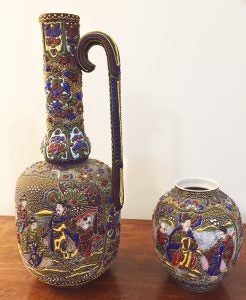Auction in Lexington yields Japanese treasure
Published 5:44 pm Friday, March 1, 2019
By JERRY SAMSPON
Personal Effects
Question: Do you know anything about Japanese Satsuma ware, Jerry? I had never heard of it or seen a piece before I spotted these at the Helm Place auction in Lexington recently. They were listed as a “vintage Kyoto Satsuma ewer and ginger jar with figural accents.”
The ginger jar is missing its lid, but otherwise they are in perfect condition, with what is called “enamel beading” in brilliant colors. There are thousands of tiny dots and lines of raised enamel which give the surface a bumpy texture. The designs are incredibly intricate and the faces are painted with very fine black lines. There is Japanese writing on the bottom of the ewer. What would it have been used for? I have no idea if I bought junk or a treasure, but I think they are beautiful, so maybe it doesn’t matter. I have a letter of provenance saying they came from Helm Place. Does that increase their value?
Answer: What a great piece. The colors and details are just stunning. You indeed have two pieces of Japanese Satsuma ware, a wine ewer and a jar. There are a lot of details in these pieces. Many times the enamel paints were applied with a tiny brush, a slip cup or even a pastry bag type apparatus. The faces were hand painted and fired first and all of those other colors were hand applied afterward.
Satsuma ware is a style of Japanese earthenware originally from the Satsuma region of what is today southern Kyushu. There are actually two types of Satsuma wares. The first is the original, a plain dark grey clay that was made in the 1600s. These wares were very simple and elegant with hand painted or scratched in decorations. Before 1790 they were not ornate. It was made for everyday use. Kyoto Satsuma was really not correct on this. Kyoto wares looked like the early satsuma from the 1600s, but
Kyoto wares were from a different company, period and region.
The other satsuma, like your pieces, were made in the latter 19th century to the 1930s. This ware is the most well-known, with an ivory background or body and bright polychrome color schemes with, at times, heavy gilding. Pieces from the early to late 1900s were heavily exported. The colors were adapted for the Western markets. Remember, this is the tail end of the Victorian period. So it’s going to be colorful.
Many pieces that were created for the Japanese market are sublimely elegant and rich. Your pieces, made for the Western market, are a tad more colorful and eye catching. Not to say that’s a bad thing, but in this case it does affect the value.
Yes, let’s talk about provenance. A provenance is the history of an item dating back to its original maker or owner. A good provenance has the ability to add value to just about any object. Well, a famous or celebrity provenance and not a typical Joe Smith, down the road provenance. Though a connection to the well-known Helm Place farm is great, it’s not going to have the importance of a piece that was directly connected to the Helms, the Townsends or even the Lincoln families. It is just a piece that was in the home at the time of its sale. But it’s good that you have any documented history to this
Kentucky icon and period of history.
You did not buy junk. However, the market has not been kind to Satsuma. For decades, collectors, dealers and scholars have called it garish, cluttered and — cheap. Serious pottery or porcelain collectors rarely cast an eye toward 99 percent of most Satsuma pieces. But, your pieces are a step above most of what you see in the open marketplace. I love its richness and details. That bold blue enamel helps elevate its value too.
I think the wine ewer or jug, which is your best piece, in a good antiques shop would be priced at about $200 and the jar, which is missing its lid, would be priced for about $75. Thanks for sharing it with us.





